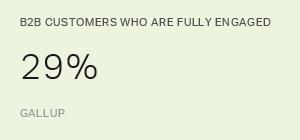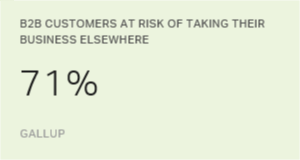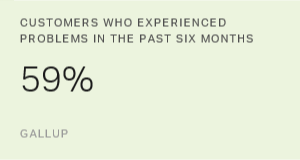Story Highlights
- Customer experience platforms aren't sufficient
- Qualitative analysis identifies key engagement drivers
- A qualitative approach to customers provides actionable insights
Over the past decade, Gallup has observed a growing arms race among brands to implement bigger and better customer experience platforms. These systems -- also called customer experience platforms, customer experience management or CEX management -- aim to capture customer feedback, analyze how a company manages and resolves customer problems and provide actionable insights to improve the customer experience.
Using this technology enables companies to quickly amass stockpiles of data about a customer's experience at each touchpoint between a customer and a company, whether interactions are online or offline, mobile or social, or in person. Many companies purchase these systems hoping that the technology will help them bridge the gap from the corporate office to the front lines, ensuring employees consistently execute on the brand promise in each interaction.
The problem is, no customer experience technology platform, by itself, can provide deep insights into why customers do what they do. These systems can track an infinite number of transactions, but they can't identify the key actions the company must take to gain more fully engaged customers.
To fully engage customers and achieve long-term growth, companies must connect with customers on an emotional level. Though customer measurement technologies offer valuable data, they often fail to provide insights into how companies can establish this emotional connection. By combining quantitative measurement with qualitative research and analysis, companies can determine which customer touchpoints carry the most emotional significance -- and which are the most likely to build customer engagement.
Significant Memories of a Brand Trump Actual Experiences
Too many companies purchase customer engagement platforms assuming that if they measure every transaction in a customer's journey, this alone will help the company increase engagement. But that assumption is flawed, because there is no built-in mechanism to measure the powerful emotions and memories that influence customer behavior.
Companies also purchase these systems assuming that past customer experiences will predict future customer behavior -- but that assumption also isn't accurate. The latest behavioral economic research indicates that memories matter more than actual experiences when it comes to predicting future customer behavior and share of wallet.
For example, Nobel Prize winner Daniel Kahneman, a leading pioneer in behavioral economics, explains the power of memory this way: Each person perceives reality from two different, sometimes competing perspectives -- the experiencing self and the remembering self. The experiencing self is present at every touchpoint throughout the customer journey, but the remembering self takes inventory of the emotional significance of each experience and ultimately decides which memories to keep.
Gallup has observed this phenomenon of memory trumping actual experience across all industries, and it plays a role in all types of customer interactions, from hospital stays to corporate purchases. On their own, experiences have marginal value if they evaporate in a customer's short-term memory. But an experience that lingers in a customer's long-term memory enables them to travel back in time and recall the events and feelings that foster emotional engagement to a brand.
Finding the Moments That Matter
Though customer experience platforms collect data at every touchpoint, they can't differentiate which moments matter most to customers -- and some moments will matter far more than others. By combining quantitative analytics with qualitative data collection and analysis, Gallup can help clients explore which customer touchpoints carry the most emotional significance -- and are the most likely to build customer engagement.
For example, a hotel chain asked Gallup to analyze hotel guest behavior to determine the touchpoints that had the greatest impact on customer engagement. Gallup used ethnographic research methods to study hotel guests, such as carefully observing their behavior across every customer touchpoint. This qualitative research determined that hotel customers experienced about 1,072 touchpoints with the brand during a typical overnight stay. After further analysis, Gallup predictive analytics identified the four or five vital touchpoints that contributed to guests' most vivid memories -- the key drivers that had the strongest influence on customers' emotional engagement with the company.
Now, identifying the key drivers didn't mean the company and its employees could ignore the other 1,067 touchpoints, because failure to deliver at these touchpoints would likely disengage a guest. But focusing on them would yield a marginal return on investment compared with focusing on the key engagement drivers.
Using Analytics to Predict Customer Actions
Most companies that purchase a customer experience platform want to increase customer engagement, which leads to crucial customer outcomes and ultimately, business growth. Gallup's quantitative analytics identified three items that predict customer behavior across all industries and across business-to-customer (B2C) and business-to-business (B2B) companies. Fully engaged customers strongly agree that the brand or company always delivers on what it promises, that it makes them proud to be a customer and that it is the perfect brand or company for them.
Now, a technology platform can't determine the key drivers that lead customers to strongly agree with those items. But Gallup's qualitative research and analysis can help B2C and B2B companies identify the key drivers that are specific to their industry, company and brand, which can help them improve engagement across those items.
In hospitality, for example, taking care of guests' well-being can lead to a healthier balance sheet if hotels do it correctly. That's because there's a strong link between guests' feelings of well-being and customer engagement. Among guests who strongly agree that the hotel they visit most frequently takes care of their well-being, 79% are fully engaged, compared with 20% who are indifferent and 1% who are actively disengaged. Among those who strongly disagree with this statement, a mere 6% are fully engaged.
Further qualitative analysis, such as ethnographic research, paired with predictive analytics can identify the company- and brand-specific drivers that will create or reinforce that sense of well-being. For example, Gallup researchers conducted a combination of targeted interviews and real-time observations of hotel guests to understand how they recognize when they feel a sense of well-being. This study uncovered attributes the hotel couldn't glean from a dashboard report or email survey: The scent of the lobby -- and the confidence exhibited by the receptionist -- lowered customers' anxiety at check-in and instilled a sense of well-being.
Similarly, in B2B scenarios, where companies provide products and services to corporate accounts, 82% of clients who strongly agree the brand is easy to do business with are fully engaged, compared with 17% who are indifferent and 1% who are actively disengaged. Among those who disagree or strongly disagree that the brand is easy to do business with, just 1% are fully engaged.
Qualitative research and analytics can also help B2B companies determine key drivers that, when fulfilled, can increase customer engagement. Ethnographic techniques, for example, can help B2B clients understand why certain behaviors matter most to their customers. For example, Gallup researchers conducted ride-alongs with top-performing account managers at a B2B company to identify specific behaviors that demonstrated "ease of doing business" to their customers. This included nuanced behaviors, such as active listening to clearly understand the customer's needs and building rapport beyond the job relationship.
An effective customer experience platform can do many things, but it can't sift through thousands of customer touchpoints to determine the vital few key drivers that shape an engaging customer experience. The best companies learn about the customer journey not just by tracking transactions, but by carefully observing how customers experience those transactions. Qualitative research can uncover the real drivers of customer behavior -- and companies ignore those drivers at their peril.



